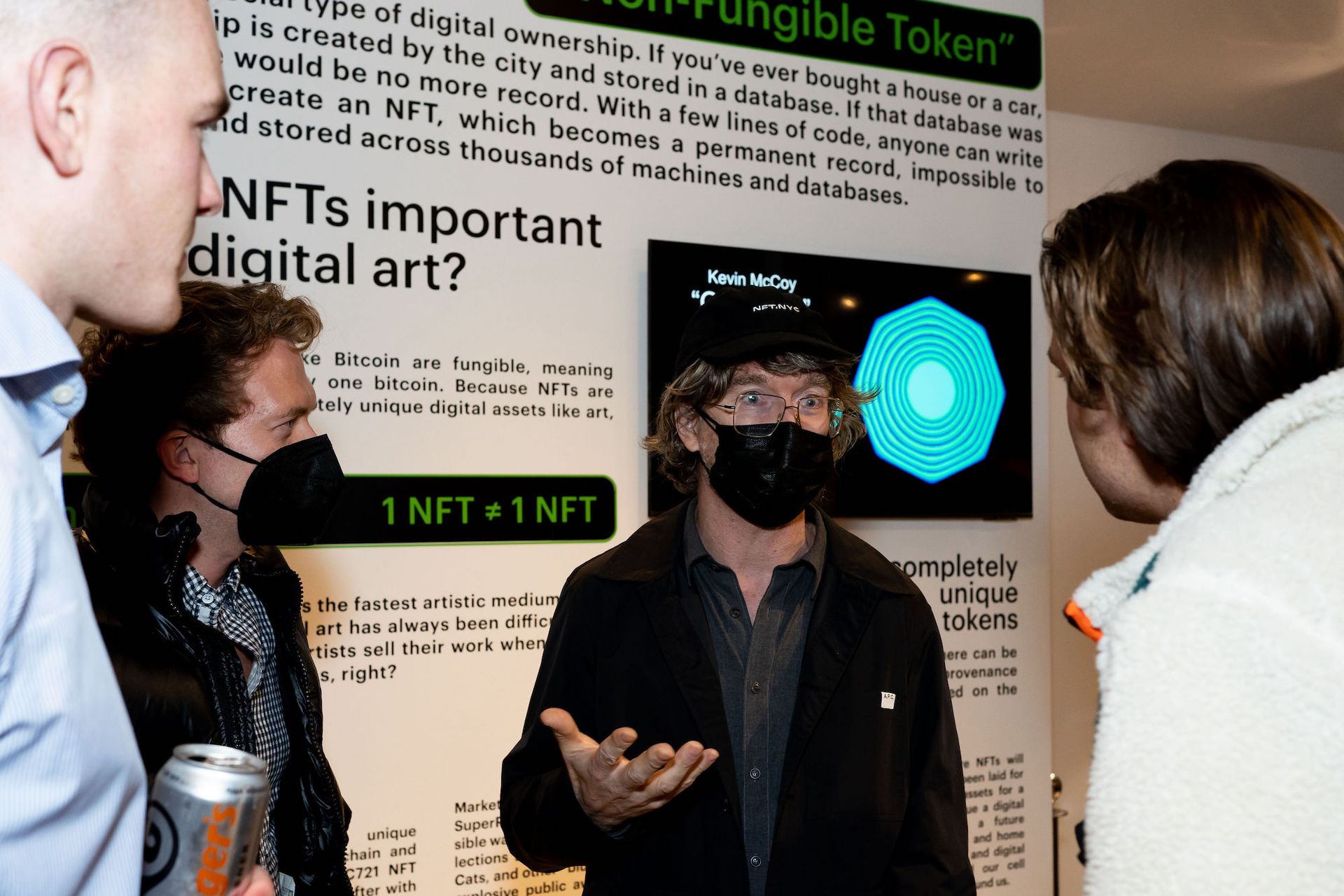27/01/2022 The Seattle NFT Museum wants to mint a new art world
The museum’s founders organised an inaugural exhibition that is acutely aware of its place in history

Kevin McCoy, co-progenitor of the NFT, speaks to visitors at the Seattle NFT Museum© nataworry Photography / Seattle NFT Museum
Kevin McCoy did not set out to terraform the art world. But on 15 January, addressing a private audience during the Seattle NFT Museum’s opening weekend, the digital artist acknowledged that the moment was nothing short of historic.
“Back in 2014, I saw blockchain technology as being transformative to how artists work, and that hunch has come true,” McCoy says in a subsequent interview. “I couldn’t have predicted exactly what shape it’s taken, and it’s pretty surprising to see how it looks now. But the energy, enthusiasm, and sense of a new world is so palpable—and it’s great.”
In less than a decade’s time, the NFT (non-fungible token) market has ballooned from a quirkySeven on Sevenexperiment by McCoy and technologist Anil Dash into apolarisingmulti-billion-dollarphenomenon, leaving many of the traditional art world’s power brokers stunned. In McCoy’s view, newcomers entering the NFT scene now have a hard road ahead of them. “The ecosystem is just filled with different chains and technologies,” he says. “That need for education is immense.”
Closing this knowledge gap is one of the ways the Seattle NFT Museum, thefirst museum devoted to the format, intends to make a measurable impact. In statements shared withThe Art Newspaperand other publications, spokespersons for the organisation outlined its role in promoting, demystifying and facilitating more widespread access to the possibilities of NFTs, along with a promise to operate with net-zero emissions. According to the institution’s website it has applied to joinThe Climate Pledge, which requires companies to reach net-zero carbon by the year 2040.
IRL NFTs and lots to read
So how is it, this physical space dedicated to digital NFTs? Exploring the museum’s galleries, which are staggered across three levels of a 3,000 sq. ft brick-and-mortar space in Seattle’s over-developed and under-resourced Belltown neighbourhood, felt not so different from visiting any other art institution. The museum mimics the white cube aesthetic so well, in fact, that weaving through the opening evening’s crowds felt largely indistinguishable from the pre-pandemic atmosphere of a Chelsea gallery crawl in full swing.
Navigating the museum’s inaugural exhibition, on the other hand, can be daunting. Equal parts historical crash course and group exhibition, the show’s layout alternates viewers’ attentions between dizzying sprawls of wall text aimed at contextualising NFTs, and large, high-resolution screens displaying a variety of digital art.The Stranger’sJas Keimigconfessed that,“[f]or once, Iwishedsomeone would mansplain this concept to me”. Chances are neither the harshest critic nor the most fervent crypto zealot would know where to start.
Wall text attempting to explain the blockchain-based system that undergirds NFTs is displayed throughout the museum. On the ground level, a crowded cluster of paragraphs traces the origins of NFTs, proceeding at length to speculate on their implications for the future of Web3. One level up, the museum’s lesson plan pivots to a somewhat technical overview of Ethereum mining machines. On the uppermost level, close to the back, a slimmer wall text titled “The Language of NFTs” lists some of the more common shorthand slang used by members of the subculture, such as DYOR (“Do Your Own Research”) and PFP, an abbreviation that refers to a type of NFT art used by fans and collectors as digital profile pictures.
The NFT canon enshrined
That the digital artworks on view share little to no thematic cohesion registers, in the context of this inaugural show, as something of a curatorial home run. Museum co-founder Jennifer Wong says the artworks on view were chosen “to address the common misconception that NFT art looks a certain way”. The decision works to the museum’s advantage, underscoring how a market still in its infancy has already given rise to its own eclectic class of greatest hits. There is McCoy and company’sQuantum(2014), regarded as the first of its kind, which is strategically placed by the entrance. Tyler Hobbs’sFidenza #361(2021) algorithm, meanwhile, stands in as a savvy example of a medium taken in a compelling conceptual direction. AndCryptoPunk #553(2017) puts in an appearance as a recognisable representative of Larva Labs’ popular collection and the PFP genre.
Despite the addition of unique features like QR codes connected to each work’s listing on the NFT platform OpenSea, the museum is not exempt from the usual technical headaches that come with presenting digital art. Early during the opening evening event, for example, a screen displaying Neon Saltwater’s three-dimensional video collageThe Flowers in the Glass(2022) encountered a momentary network interruption that museum staff had to troubleshoot in real time.
A screenshot of a minted POAP for attending the Seattle NFT Museum’s opening weekend event© Rain Embuscado
“We believe that the line between art and technology is starting to blur,” says Peter Hamilton, who co-founded the museum with Wong. “From the very top level digital art has been greatly underrepresented. NFTs are planning to elevate that. But beyond that, there’s so much that can happen with a smart contract, with AI, with generative art experiences, and math and the beauty of patterns.”
For my part at least, figuring out how to secure the minted POAP (Proof of Attendance Protocol) badge that the museum sent me home with will be the greatest indication of how accessible the technology can be. As the saying goes:WAGMI.
- TheSeattle NFT Museumopens to the public 27 January, Seattle, Washington
 (0)
(0)
 (0)
(0)
https://www.theartnewspaper.com/2022/01/26/seattle-nft-museum-new-art-world-review
